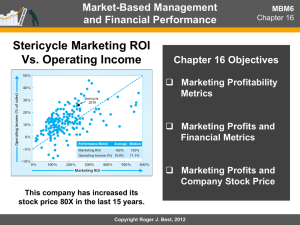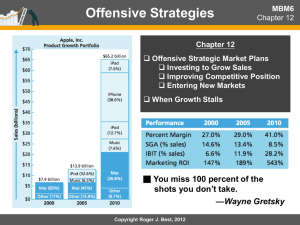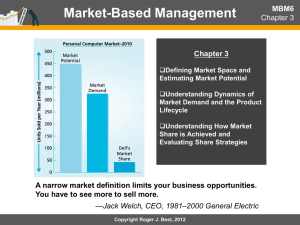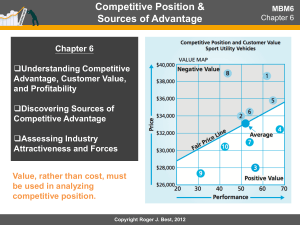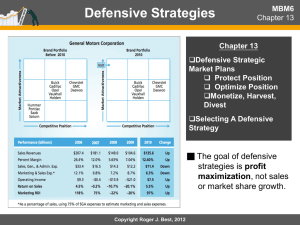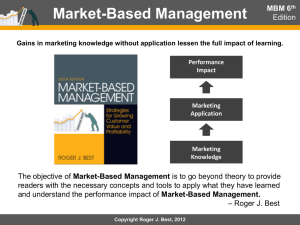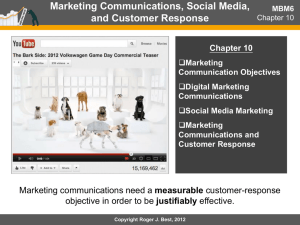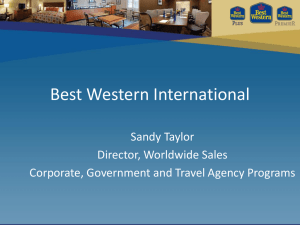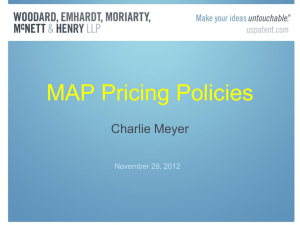MBM6
advertisement
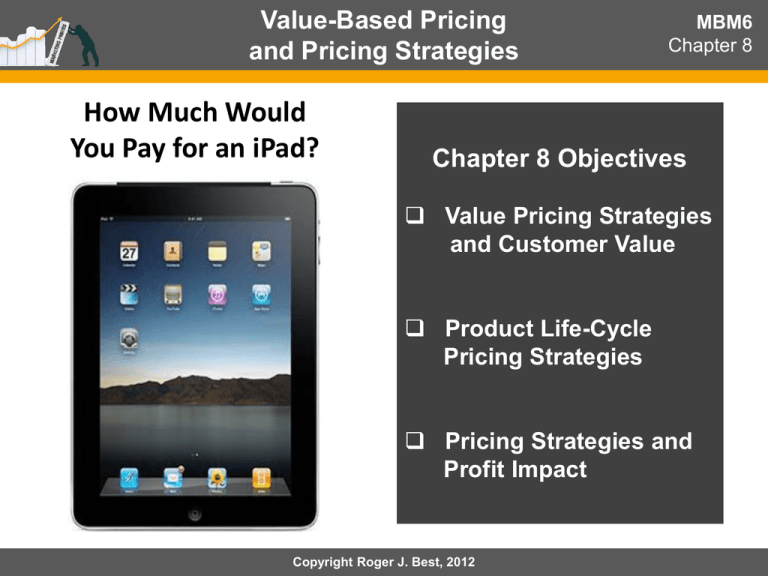
Value-Based Pricing and Pricing Strategies How Much Would You Pay for an iPad? MBM6 Chapter 8 Chapter 8 Objectives Value Pricing Strategies and Customer Value Product Life-Cycle Pricing Strategies Pricing Strategies and Profit Impact Copyright Roger J. Best, 2012 Value-Based Pricing and Pricing Strategies MBM6 Chapter 8 Pre-Launch Price Research How Much Would You Pay for an iPad? Mac Users • 41% would pay over $800. • 32% would not pay over $600. PC Users • Only 20% would pay over $800. • 64% would not pay over $600. Copyright Roger J. Best, 2012 Apple iPad Pricing Strategy MBM6 Chapter 8 Six price-performance iPads cover customer price preferences. Copyright Roger J. Best, 2012 Apple iPod Pricing Strategy MBM6 Chapter 8 Launch iPod with a high price and capture high end of the market. Later add Touch at a higher price and Nano and Scuffle at lower prices. Copyright Roger J. Best, 2012 Value-Based Pricing and Pricing Strategies Value Pricing Strategies & Customer Value This section focuses on different approaches to value pricing. Copyright Roger J. Best, 2012 MBM6 Chapter 8 Cost-Based vs. Market-Based Pricing MBM6 Chapter 8 Cost-Based Pricing: Starts with cost and desired margin and is marked up along the channel to a customer selling price of $940 Market-Based Pricing: Price is set based on competitive advantage and value ($1000) and discounts and costs deducted to arrive at a company margin. Copyright Roger J. Best, 2012 Under-Pricing a Digital Camera MBM6 Chapter 8 Cost-Based Pricing With a unit cost of $125 and desired margin of 50% price was set at $250. At that price 60% of the market would buy this product and produce a gross profit of $187.4 million. Market-Based Pricing The price is set at $350 based on a market price that would produce the highest gross profit. At that price 40% of the market would buy this product but it would produce a gross profit of $225 million. Copyright Roger J. Best, 2012 Over-Pricing a Digital Camera MBM6 Chapter 8 Cost-Based Pricing With a unit cost of $250 and desired margin of 50% price was set at $500. At that price 10% of the market would buy this product and produce a gross profit of $63 million. Market-Based Pricing The price is set at $400 based on a market price that would produce the highest gross profit. At that price 30% of the market would buy this product but it would produce a gross profit of $113 million. Copyright Roger J. Best, 2012 Cost of Car Ownership MBM6 Chapter 8 Assume the price of a new Honda Civic is $20,000 and is owned for 3 years. What are the ownership costs a buyer should consider in buying this car? Copyright Roger J. Best, 2012 Value In-Use Pricing The company price its product 10% higher than their competitor. Why would a customer pay more for this product? Copyright Roger J. Best, 2012 Marketing Performance Tool 8.1 Life-Cycle Value Pricing MBM6 Chapter 8 BioTronics charges $10,000 more for their bio-electronics product than their main competitor. The product life is 5 years. Why would a customer pay more for the BioTronics product? Copyright Roger J. Best, 2012 Why Pay More For This Product? Based on customer ratings of the business and 3 competitors, this business was rated: • 20% higher on product performance • 27% higher on service quality • 34% higher on company reputation • 20% higher in price of equipment • 20% lower on service & maintenance. Why would a customer pay 20% more for this company’s product? Copyright Roger J. Best, 2012 Marketing Performance Tool 8.2 Price-Performance Trade-Offs Marketing Performance Tool 8.3 Quality-Conscious Customer: What are their performance drivers? How important is price? Why would a product priced at $3.00 per sq. ft. with full trim finish and painted out sell a product a $1.00 per sq. ft. that has a basic trim finish and is unpainted? Copyright Roger J. Best, 2012 Price-Performance Trade-Offs MBM6 Chapter 8 Price-Conscious Customer: What are their performance drivers? How important is price? Why would a product priced at $3.00 per sq. ft. with full trim finish and painted not sell when a product a $1.00 per sq. ft. that has a basic trim finish and is unpainted would sell well? Copyright Roger J. Best, 2012 Customerization Value Pricing MBM6 Chapter 8 * * The Reference Price includes all advanced features . Why would a customer feel this is a good value at a PC price of $1000? Copyright Roger J. Best, 2012 Top-Down Price Presentation MBM6 Chapter 8 Research has shown that: Top-Down presentation (highest priced to lowest) results in higher priced purchases. Bottom-Up price presentation results in lower price purchases. Why? Copyright Roger J. Best, 2012 Value-Based Pricing and Pricing Strategies Product Life-Cycle Pricing Strategies This section focuses on different pricing strategies for different stages of the product life-cycle. Copyright Roger J. Best, 2012 MBM6 Chapter 8 Starbucks Brand Strategy MBM6 Chapter 8 Why is a skim pricing strategy often used during the early growth phase of the product life cycle? Copyright Roger J. Best, 2012 Starbucks Brand Strategy How is a Single Segment price strategy different than a Skim price strategy? Copyright Roger J. Best, 2012 MBM6 Chapter 8 Starbucks Brand Strategy MBM6 Chapter 8 Why would a company pursue a penetration (low price) strategy during the early growth stage of the product life cycle? Copyright Roger J. Best, 2012 Starbucks Brand Strategy MBM6 Chapter 8 What is the difference between a Low-Cost Leader pricing strategy and Penetration pricing strategy? Copyright Roger J. Best, 2012 GE Multi-Segment Strategy MBM6 Chapter 8 Penetration Price Why would it be more profitable for GE to serve two segments with a Multi-Pricing strategy than one segment with a Penetration price strategy? Copyright Roger J. Best, 2012 Starbucks Brand Strategy Why is Plus-One pricing strategy important in late growth and mature markets? Copyright Roger J. Best, 2012 MBM6 Chapter 8 Reduced Price Strategy MBM6 Chapter 8 Why would a Reduced Focus price improve profits while lowering sales? How could NetFlix have used this strategy? Copyright Roger J. Best, 2012 Harvest Pricing Strategy MBM6 Chapter 8 Why is Harvest pricing most likely to be use in mature or declining markets? Explain why many who raise prices with the intention of exiting a market find it more profitable to stay in the market? Copyright Roger J. Best, 2012 Value-Based Pricing and Pricing Strategies Pricing Strategies And Profit Impact This section focuses on different approaches to value pricing. Copyright Roger J. Best, 2012 MBM6 Chapter 8 Profit Impact of Mac Price Decrease Marketing Performance Tool 8.4 ??? ? Current: In 2011 the Apple sold 16.8 million Macs at an average price of $1300. This produced $21.83 billion in sales and $5.46 billion in gross profit. Analysis: If in 2012 Apple lowered the average price to $$1249, how many more Macs would they sell (best guess)? Copyright Roger J. Best, 2012 What If a Price Decrease to $1249 Yields a 10% Volume Increase? MBM6 Chapter 8 Why did the Mac sales increase but the gross profits decrease? Analysis: If in 2012 they lowered the average price to $1249 and volume increased by 10% (1.68 million units), sales would increase by over $1 billion but gross profits would decrease.$400 million. Hold Profits: For this price decrease to just maintain current profits would require a volume of 19,93 million ( a 6.6% market share). Copyright Roger J. Best, 2012 MBM6 Chapter 8 Mac Price Elasticity Price Elasticity = % Change Volume = 10% Change Volume % Change Price -3.9 % Change Price = -2.55 When the percent change in volume is greater than the percent change in price, we have an elastic price. Copyright Roger J. Best, 2012 What About a Mac Price Increase? MBM6 Chapter 8 ??? ? Analysis: If in 2012 Apple raised the average price to $1349, how much would the Mac volume go down (best guess)? Copyright Roger J. Best, 2012 What If Price Was Increased to $1349 and Volume Decreased by 1.8% MBM6 Chapter 8 Why did the Mac sales and gross increase? Analysis: If Apple raised the average price to $1349 and volume increased by 300,000, sales gross profits would increase. Why? Hold Profits: Apple could lower volume sold to 14.6 million and still maintain current profits. Any volume sold over 14.6 million would produce a higher gross profit. Copyright Roger J. Best, 2012 MBM6 Chapter 8 Mac Price Elasticity Price Elasticity = % Change Volume = -1.8% Change Volume % Change Price 3.8 % Change Price = -.47 When the percent change in volume is less than the percent change in price, we have an inelastic price. Copyright Roger J. Best, 2012 Price Elasticity and Profit Impact MBM6 Chapter 8 Inelastic Prices: Never lower price when a price is inelastic. A lower price will result in lower sales and lower profits. Elastic Prices: Use caution when lowering prices when prices are elastic. If percent margins are low, a lower price will increase sales but often result in lower profits. Copyright Roger J. Best, 2012 Breakeven Market Share MBM6 Chapter 8 Breakeven Analysis • Volume where zero profits occur is 24 million units. Breakeven Volume: = Fixed Expenses (Price – Unit Cost) Breakeven Market Share: = Breakeven Volume Market Demand Why is breakeven market share a better marketing profitability metric? Copyright Roger J. Best, 2012 Product Line Price Elasticity’s MBM6 Chapter 8 Why does price elasticity tend to increase with market share? (Note: the diagonals are brand price elasticity’s) If Tide raised their price by 10%, the Tide volume would go down by 13.9% and the Surf volume would increase by 4.6% Copyright Roger J. Best, 2012
